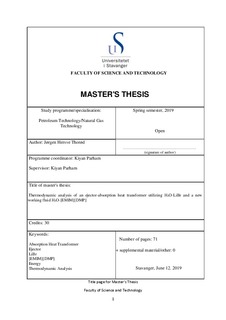| dc.description.abstract | The focus on human impact on the environment has increased within recent decades. Several large concerns regarding the threats to the stability of the environment have been brought up in public discussions. Amongst the greatest of these concerns are climate change. The public pressure on policy makers for combating climate change can perhaps be felt the easiest in the energy sector. Politicians, policy makers and consumers are looking to innovation and implementation of new technologies to aid the goals that have been set by numerous climate change agreements, most notably the Paris Agreement of 2016. In addition, a booming world population brings with it fast growing middle classes in developing countries, meaning that finding new methods for creating or improving energy production is of the utmost importance for the foreseeable future. One such method for improving upon the energy efficiency of pre-existing industries, or for better utilization of renewable energies is the implementation of absorption heat transformers. Absorption heat transformers is the second category of absorption heat pumps. It is a thermodynamic cycle, which can upgrade heat through an absorption process. This is done by taking in low to mid-grade waste heat from industry or from renewable energies such as geothermal heat or solar ponds and using a working fluid to drive an absorption reaction. It is based on an exothermic reaction which results in upgraded heat. The upgraded heat can be extracted and utilized in an array of different applications. These applications range from desalination to hydrogen production and energy recovery.
Across the decades, substantial research has gone into different types of working fluids and configurations of AHTs. Conventionally, working fluid pairs H2O-LiBr or NH3-H2O have been used, but these have had problems such as crystallization in the case of LiBr, and toxicity and high pressures for NH3. In recent years, research into the application of ionic liquids have been done to find replacements for the conventional solutions. Water and 1-Ethyl-3-methylimidazolium dimethyl phosphate or H2O-[EMIM][DMP] is one such ionic liquid (IL) solution. Amongst new ways of configuring AHT cycles, adding an ejector before the absorber is one that has been investigated in the past. However, literature on the subject is sparse, and studies done on an ejector-absorption heat transformer (EAHT) using IL solution has not been done yet.
The main objective of this thesis is to investigate the effect of adding an ejector to a single-stage absorption heat transformer using both H2O-LiBr and H2O-[EMIM][DMP] as the working fluids. For this purpose, a thermodynamic analysis is carried out, and the results are evaluated through the performance indicators of COP, ECOP, gross temperature lift, flow ratio and solution concentration difference. The working fluid crystallization risk is also investigated. The results are compared against the case without ejector by using graphs and tables. The thermodynamic analysis is carried out on Engineering Equation Solver (EES) from the perspective of the first law of thermodynamics (energy analysis).
The results indicated that [EMIM][DMP]-H2O benefit more from the addition of ejector, having a superior performance increase compared to that of LiBr-H2O. In fact, the performance of the system using LiBr-H2O degraded over large portions of the investigated temperature ranges, only gaining an increase to its performance at high temperatures. But still, LiBr-H2O continues to perform better than [EMIM][DMP]-H2O generally when comparing the performances of both the two solutions against each other. The addition of ejector was found to be potentially helpful in lowering the crystallization risk of LiBr-H2O, by allowing the system to start up at lower generator temperatures and substantially improving its performance at lower generator temperatures. To conclude, the addition of ejector is recommended generally for AHT systems. | nb_NO |
